Tamela Rich's Blog, page 3
March 27, 2017
Tuscany Italy by Motorcycle: Crete Senesi and Pienza
There’s nothing like a few days in Italy to turn even a fast-food junkie into a foodie. Italians are proud of their culinary heritage and my tour guide, Enrico Grassi is a goodwill ambassador of all things cultural and gastronomical in the boot-shaped country.
Even scenic pullovers are an opportunity for Enrico to give us a lesson in Italian cuisine.
The Crete Senesi landscape
As we leave Siena en route to Orvieto, our first stop is at a pullover to ooh and ahh at Crete Senesi, a remarkable landscape. The name literally means “Senese clays” and the distinctive color of the landscape comes from the sediments of the Pliocene Sea that covered the area roughly 2.5-4 million years ago.
Enrico stages a group photo there and I think every single one of us took a panoramic shot (like mine here) with our phones.
 The spectacular Crete Senesi landscape grows lots of tasty foods!
The spectacular Crete Senesi landscape grows lots of tasty foods!
Despite looking other-worldly, the clay soil is ideal for growing the region’s famous crops and livestock. Back home in North Carolina, the only thing our red clay grows is pottery and bricks!
Follow this Italy Series
Pecorino cheese, prosciutto ham and Steak Florentine
Enrico explains to us that sheep milk from this region produces pecorino cheese. It owes its unique flavor to the scented bushes and herbs of the Crete region that comprise the sheep’s diet: artemisia, goat’s beard, sweet cicely, musk milfoil, popolino, and bird’s-foot trefoil.
When aged it is hard —like Parmesan. Younger pecorino is soft like a firm brie, with a milder taste. Pecorino cheese in these parts is basically a family product, and folks are rightly proud of it. As Enrico explains in the video above, the Tuscans also play field games with the cheese rounds!
Enrico also told us to watch for another distinctive animal in the region, the Sienese Cinta, a white-belted black pig. Its prosciutto ham is obtained exclusively from animals slaughtered at between 12 and 15 months. After slicing, the ham undergoes salting, then is desalted, left in the refrigerator and peppered, and finally aged on wooden slabs.
I don’t recall seeing any of the pigs, but we did pass a herd of another legendary animal, immortalized in some of ancient Rome’s famous art sculptures—the giant and majestic Etruscan Chianina.
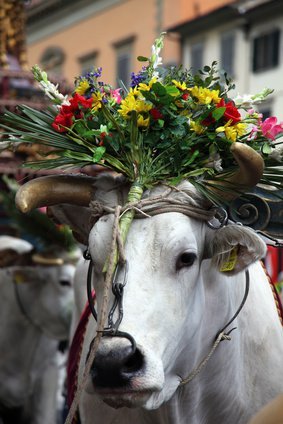 Italy’s majestic Etruscan Chianina spiffed up for a festival
Italy’s majestic Etruscan Chianina spiffed up for a festivalKnown as the “white bull of central Italy” we recognized a herd from Enrico’s description as we rounded a curve and they turned their faces to watch us, their white and slightly downturned horns looking as though they were dipped in black paint at the tips.
Steak Florentine comes from these animals. If you order the dish in Italy they won’t even ask how you want it prepared. Because the Italians know best how to serve you, you’ll get it rare and you’ll enjoy it. Period.
A Pienza dance party
As with every other September day on our tour, the weather is spectacular: sunny and in the low 70’s (and as a resident of the American South, I must also add, “with mercifully low humidity”). For lunch, we head to Pienza, considered the “ideal city of the Renaissance.”
Originally called “Corsignano,” the town was transformed by the vision of a hometown boy who later became Pope Pius II. After the city’s rebirth he renamed it “Pienza” which means “pius,” proof that Renaissance popes knew the power of branding.
Entering the city an accordion player and percussionist are singing and playing in the Piazza Martiri della Liberta and am delighted when a dance party breaks out. Two slim bicyclists in their 60’s or 70’s, wearing yellow hi-viz riding gear steal the show with their flamboyant moves while an American woman in dark sunglasses dances and twirls, holding the ten-euro bill she intends to place in the buskers’ suitcase.
They call themselves “Chorobodo” and specialize in Brazilian-Italian peasant songs. Brilliantly so.
Here I am living la dolce vita. No electricity, lights or backstage passes required. Simple living, simple instruments, simple pleasures. See for yourself in the video at the top of this post.
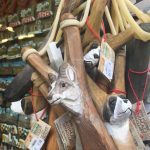
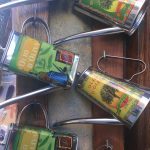

Follow this Italy Series
After doing some souvenir shopping and eating a bite of lunch we saddle up for Umbria by way of Sarteano, a city rich in Etruscan archeology. The Museo Civico Archeologico di Sarteano (Archaeological Museum of Sarteano) is waiting for my next visit, since we are there for a quick potty/coffee/gelato break.
Speaking of gelato, the coffee shop on the piazza doesn’t make its own, as many do, but has some prepackaged gelato treats. I ask Enrico which one he recommends, and after surveying the freezer cabinet, says he can’t recommend any of them in good conscience. Apparently there is “junk food” in Italy after all, and Enrico is my human shield.
I’ll tell you more stories from Italy this year, since I’m returning to ride my motorcycle through Tuscany, Corsica, and Sardinia in 2017. Subscribe in the purple button above and you’ll never miss an installment of the story.
Here is the beginning of the series. The next installment is from Orvieto, rich in Etruscan heritage.
The post Tuscany Italy by Motorcycle: Crete Senesi and Pienza appeared first on Tamela Rich.

March 17, 2017
Tuscany Italy by Motorcycle: Siena
Awake once more at dawn in my 400-year-old room, I’m eager to get into Siena. The shimmering city on three hills that has been enticing us from the infinity pool at Podere la Strega is now on our agenda.
Our guide Enrico will lead an optional ride in the afternoon, but we are free to spend the day as we please. Early risers Jo and Dan were first to leave for Siena since they want to be back for the ride to the Abbey of San Galgano in the afternoon.
 Siera from the infinity pool at Podere la Strega
Siera from the infinity pool at Podere la Strega
Karen, Danette, and I pile into Letizia’s Volkswagen as Italian music wafts from her radio. The proprietor of Podere la Strega and Enrico are cooking our evening meal themselves, so she offered to drop three of us in Siena on her way to picking up fresh ingredients at the market. Fresh food is an obsession of the Italians that I share.
Women On Wheels® in Italy
Danette, Karen and Jo are members of the international motorcycle club Women On Wheels®. I originally met Danette at one of its events three years ago. Jo and Karen are my “Italian friends” since we met through this tour.
Danette retired from a career with the US Army in public relations and journalism after traveling the world extensively in her uniform. While she is too modest to call herself a linguist, she can navigate the written and spoken word with impressive accuracy. She has a great eye for detail and an inner compass that helps us navigate the winding vias (streets).
Karen is Kansas City, Missouri born and bred. After a career with the Internal Revenue Service, her new mission in life is putting as many miles on her motorcycle as possible, at home and now abroad. She carefully noted the beginning and ending kilometers on her bike so that her Italian mileage would count for a club contest at year end.
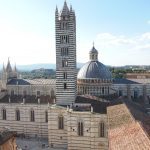
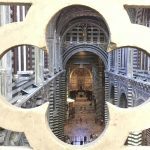

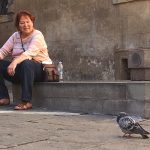
Siena’s monumental cathedral complex
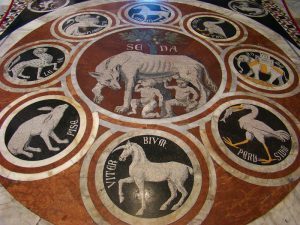 Photo credit creative commons: Tango7174
Photo credit creative commons: Tango7174Karen researched our itinerary in depth, especially Siena, and she shared some of what she learned over lunch. The three of us concur that the cathedral is our must-see of the day. Its white marble facade and the grey- and white-striped bell tower, (campanile) contrast with every other “sienna-colored” structure in the walled city.
Everything about the cathedral is over the top, but I can’t keep my eyes off the floor. We were fortunate to be in the cathedral during one of two seasons when the floor coverings are removed to reveal its magnificent mosaics.
Crafted by about forty artists and artisans between the 14th and 16th centuries, the 56 mosaic panels vary in size and shape. My favorites are the oldest:
The Wheel of Fortune (Ruota della Fortuna), laid in 1372 (restored in 1864).
The She-Wolf of Siena with the emblems of the confederate cities (Lupa senese e simboli delle città alleate) is pictured here, and said to date from 1373 (also restored in 1864).
The Four Virtues (Temperance, Prudence, Justice and Fortitude) and Mercy date from 1406.
There are several tour options on the cathedral complex menu, and Danette and I buy the “full monty.” This means we climb at least a mile on spiral staircases (that were no doubt sufficiently wide for Medieval folk) before the afternoon is finished. No worries about making my goal of 10,000 daily steps!
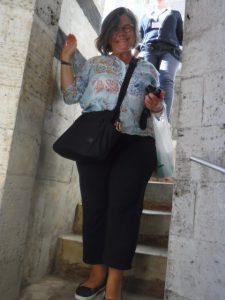 Tamela on the stairs from the gate of heaven
Tamela on the stairs from the gate of heavenKaren decides that instead of joining us on the equivalent of a mountain hike to the Gate of Heaven, and another to the overlook at the Museum dell’Opera, she will be gentle with an old leg injury. She people- and pigeon-watches in the Piazza del Duomo, and although Danette and I wave and call to her from the panoramic terrace of the Duomo Nuovo, the human voice cannot carry from over 300 feet above. The views are spectacular.
Follow this Italy Series
The Museum dell’Opera is filled with original art pieces from the cathedral and neighboring churches. I’ll leave the architectural and art critiques to those with the right credentials; to my unschooled eye it is both breathtaking and overwhelming. By the end of the day I can’t look at another Madonna, crucifix or nativity scene, even those fashioned by Donatello and Michelangelo.
Piazza del Campo
Danette and Karen still have an appetite for more religious art, so I tell them that I’ll meet them in the town square—called the Piazza del Campo, or il Campo for short—while they enjoy the embarrassment of Siena’s riches in the cathedral complex.
Merchants selling commemorative souvenirs around the perimeter of il Campo do a brisk trade, including the postcards and Tshirts they sell to me. I always ask friends and social media followers if they want postcards from my travels and for this trip I had over 100 takers!
The center of historic Siena hosts world-famous bareback horse races in an event called the palio di Siena. If you saw the James Bond movie, Quantum of Solace you’ll remember the famous horse race scene. The horses each represent a contrada—a neighborhood—of Siena. Ten of the 17 contrada usually enter the Palio.
Here’s that Bond scene:
Siena’s Gaia Fountain
I get a gelato and find a seat at the Fonte Gaia (“fountain of joy”) opposite the town hall. The fountain’s sculptures were originally produced by one of the most celebrated sculptors of the 1400’s but the only thing I notice about them is their role as minor players in the pigeon show. Jumping from the laps, heads, hands and noses of religious and mythical characters, the pigeons bath, drink and squabble to my delight. I could watch them carry on for hours.
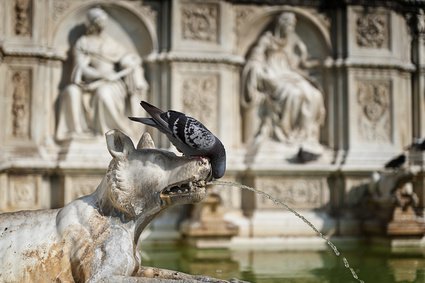 Pigeon drinking from Fonte Gaia in Siena
Pigeon drinking from Fonte Gaia in SienaMy gaze drifts to the others enjoying the square. Children chase pigeons; couples hold hands or lie on the sloped brick ground; millennials in backpacks make dozens of attempts at the perfect selfie stance and face. I’m embarrassed on their behalf and avert my gaze, wondering, why don’t they just ask someone to take a shot for them?
Okay, old-fart rant over.
Al fresco dining
After another sumptuous al fresco meal cooked in the outdoor kitchen, our merry band of motorcyclists feels bittersweet about moving on to Orvieto in the morning. But move we must.
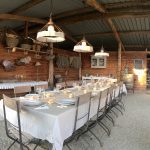
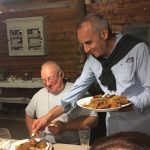
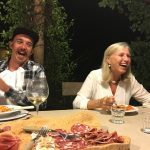
Funny factoid about the phrase “al fresco.” While it originated in Italian, they prefer to say “fuori” or “all’aperto” when describing an outdoor meal. The expression “al fresco” usually refers to spending time in jail. Who knew?
I’ll tell you more stories from Italy this year, since I’m returning to ride my motorcycle through Tuscany, Corsica, and Sardinia in 2017. Subscribe in the purple button below and you’ll never miss an installment of the story.
Here is the beginning of the series. The next installment will include our encounter with the lunar landscape at Crete Senesi en route to Orvieto.
Follow this Italy Series
The post Tuscany Italy by Motorcycle: Siena appeared first on Tamela Rich.

March 11, 2017
Italy by Motorcycle: Negotiating with a Greve in Chianti Shopkeeper
After leaving San Gimignano we head to Greve in Chianti, the birthplace of Giovanni da Verrazzano. He is famous for being the first European to explore the Atlantic coast of North America between Florida and Newfoundland, and for discovering the New York Bay in 1524. This discovery is why the bridge spanning the Narrows between Brooklyn and Staten Island bears his name.
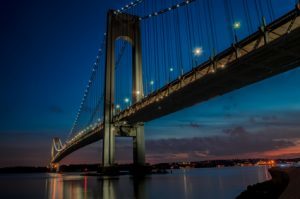 Verrazano–Narrows Bridge seen at dusk
Verrazano–Narrows Bridge seen at duskWhile Christopher Columbus looms large in the pantheon of New World Italian explorers, Verrazzano was no slouch. Verrazzano made two additional voyages to the New World, making his way as far south as Brazil in one voyage. On his third, he met his death in the Caribbean at the hands of cannibals.
Our guide Enrico takes nationalistic pride in Verrazzano, and Italian-American Jo is the only one in our tour group who answered the quiz question about him correctly at dinner the night before. Her father Giovanni would be proud of his girl.
Greve in Chianti
Arriving that sunny afternoon, we are in luck—Greve in Chianti is hosting an open-air pottery festival. After parking the bikes we head toward the Piazza Matteotti.
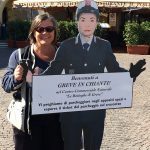
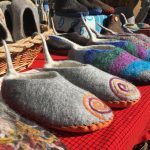
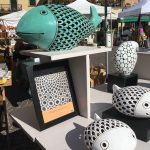
In the via I spy a yarn shop and tell the others to go ahead, and not to wait for me. I’ve been waiting for this moment for some months, not knowing when it would arrive. I will buy yarn that I can take home to knit into my own souvenir.
Inside the little shop are all manner of knitted and crocheted hats, scarves, shawls and ponchos. The bespectacled shopkeeper smiles broadly and says, “Buongiorno,” in greeting. I see some bulk yarn in blue, black and tan colorways wrapped around spools and tucked under a bench. This lack of prominence tells me that she doesn’t sell a lot of yarn, rather, that she specializes in the garments themselves.
When I think about how I will ask if the bulk yarn is for sale, I quickly realize that my language skills are inadequate. She is equally stumped in English, which I find unusual for polyglot Italian merchants.
Google Translate app to the rescue
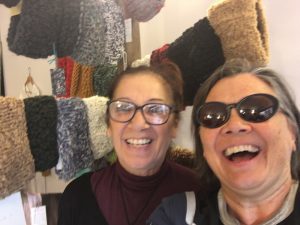 I take the world’s worst selfies, but here’s the yarn shopkeeper!
I take the world’s worst selfies, but here’s the yarn shopkeeper!Whipping out my phone I hold up a finger to this woman in the universal gesture of “hold on a moment,” and fire up the Google Translate app on my phone. We are able to communicate fairly well by typing phrases into the app, making exaggerated hand gestures and smiling a lot.
We DO have one language in common: wool.
It occurs to me at one point that she thinks I want to buy some yarn so that SHE can make it into something FOR me. We eventually work that out and then we come to price. She is accustomed to selling the yarn by weight but I want the entire blue spool.
After Google Translate helps us understand each other on that point, I ask how many euros, and think I hear her say, “fifty.” I’m willing to pay fifty euros because the yarn is of great quality and there’s plenty of it. To my surprise, she holds up two five-euro notes to illustrate her point and I’m delighted to save forty euros on the transaction!
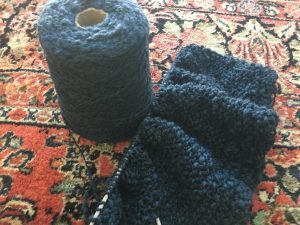 Here’s the yarn and my work in progress
Here’s the yarn and my work in progressWe get a selfie together and I am on my way, feeling pretty resourceful. I mentally pat myself on the back and then find my friends in the piazza to tell them what I just accomplished.
Follow this Italy Series
Chianti’s black rooster
Black roosters are not only prominent in the piazza, they are everywhere in the Chianti region.The profile was the emblem of the historic Chianti League, which ruled the region from the beginning of the 14th century.
The Gallo Nero (“black rooster” or “black cockerel”) is the registered trademark of the “Consorzio del Vino Chianti Classico Gallo Nero” a trade organization that guarantees a bottle of real Chianti wine. Enrico has arranged a wine tasting for those in our group who are interested, so after a sojourn in Greve in Chianti, we make our way back to Podere la Strega, our luxurious agriturismo.
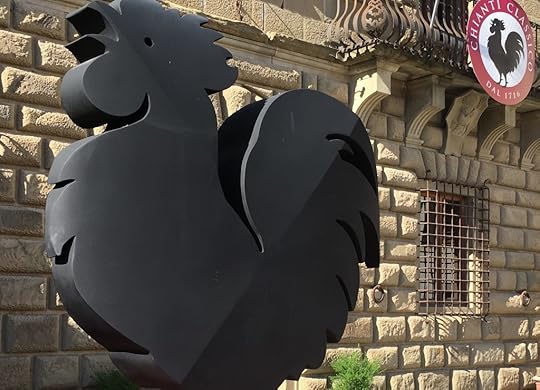 The gallo nero is everywhere in the Chianti region. This one is in the Piazza Matteotti.
The gallo nero is everywhere in the Chianti region. This one is in the Piazza Matteotti.A Stroll in the Olive Groves
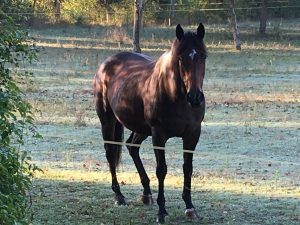 Horse in the olive groves at Podere la Strega
Horse in the olive groves at Podere la StregaWhile the wine tasting is in progress at Podere la Strega I tell the group I’m going for a stroll in the olive groves and will be back in time for dinner. Denean from Louisiana asks to go with me, “I’ve had enough to drink,” she confides.
As we make our way down the gravel path between the groves toward a horse pasture at the bottom of the hill, she tells me this is the best week in her entire life. So far it’s been a difficult year; her husband’s death being the toughest of many trials. Back home, her father had a spinal tap today in hopes of a diagnosis that has eluded doctors for several months. She and her mom and daughter have been running the family business during his illness.
She says she wants to bring her mother to Italy to slow down and smell the roses as the Italians know how to do. Maybe she’d even like to move here permanently. “I don’t need half the stuff I own,” she says, echoing my own thoughts, “What I need is time with the people I love, good food, and less pressure.”
Amen, sister.
My mind goes back to the VENDI sign in Ronciglione and I imagine life in the slow lane with a sigh.
Although there are fabulously wealthy people in every country, including Italy, it strikes me that the everyday folks whose villages we glide through and visit are rich in their culture and each other, more than their material possessions. I don’t want to romanticize this, but I must give it its due.

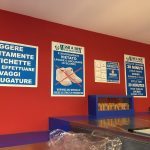

Their wash hangs out on clotheslines and is draped over balconies not simply to save electricity, also because their homes aren’t big enough for laundry rooms— and in some cases, even washing machines. I don’t think this is cause for misery.
There is a lavanderia a gettoni (laundromat) in every village that I wouldn’t hesitate to use if I lived there. No doubt this shared resource is part of the social glue of community life, where people can gossip, laugh, and commiserate about life’s vicissitudes.
Moto Guzzi or BMW?
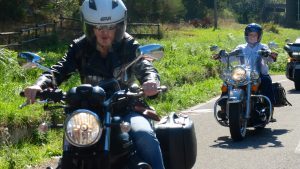 Denean on the Moto Guzzi
Denean on the Moto GuzziAs the dusk intensifies Denean thanks me for switching bikes with her in Rome. She loves her rented Moto Guzzi. I had intended to ride that bike for the novelty of riding an Italian bike in Italy (“when in Rome, do as the Romans do”). She contracted to ride the BMW G 650GS, and when got her first look at the bike, I saw revulsion in her eyes.
Let’s face it, GSes are the mule of the motorcycle world: ugly to look at while extremely effective at what they do. Denean simply couldn’t see herself on that bike. The Guzzi was similar to the Harley-Davidson Sportster she rides at home and her heart was set on it.
Just to see what I had missed, I took the Guzzi for a spin at one point during the tour, and the GS definitely corners better. Its upright ergonomics didn’t make my back ache by day’s end as the Guzzi’s would have done.
I switched to help her, and the karma played out to our mutual favor. Life is good.
I’ll tell you more stories from Italy this year, since I’m returning to ride my motorcycle through Tuscany, Corsica, and Sardinia in 2017. Subscribe in the purple button below and you’ll never miss an installment of the story.
Here is the beginning of the series. The next story will be about “art overindulgence” in Siena.
Follow this Italy Series
The post Italy by Motorcycle: Negotiating with a Greve in Chianti Shopkeeper appeared first on Tamela Rich.

March 3, 2017
Tuscany Italy by Motorcycle: San Gimignano
I awake on the third day of my tour in a 17th-century country house and it occurs to me that human beings have been conceived, born, lived, and died in this very room for over 400 years. The walls are freshly-painted plaster, their yellow hue the perfect shade for the faint early morning light.
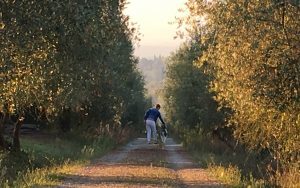 A guest walks her poodle at Podere la Strega
A guest walks her poodle at Podere la StregaI move to my closet door—likely 200 years old, since its boards are held together by handcrafted nails—and pull out a wrap for my shoulders as I head toward the window over my writing desk. I left it open all night to soak up the fresh, cool country air. Poking my head outside I see another guest walking her standard poodle toward a gravel lane between the olive groves.
A rooster crows.
Podere La Strega
At the risk of sounding trite, I want to pinch myself. The tranquility and beauty surrounding me are unlike anything I’ve experienced elsewhere. Architects, designers, and the Disney Imagineers spend their careers attempting to replicate the simple and timeless elegance that proprietor Letizia Nuti achieved here in Tuscany.
Named Podere La Strega (“farm of the witch”), the house, infinity pool, gardens and views are perfect in minute detail. You’ll see that in the pictures below and the video at the top of this post.
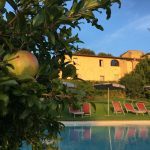

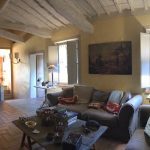
I don my riding pants and boots, then head down for breakfast. Our group’s official early risers, Dan and Jo, are on their second cup of coffee and laugh with Enrico about last night’s meal, which would have met with Jo’s father Giovanni’s approval.
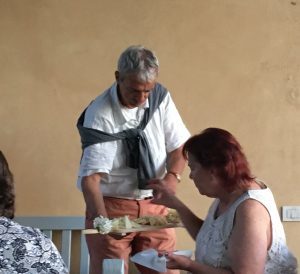 Hors d’oeuvres on the side porch at Podere la Strega
Hors d’oeuvres on the side porch at Podere la StregaThe temperate late-September weather means we eat all of our meals outside, either under a portico off the side of the house, or across the lawn at a long table in a summer dining room.
For our arrival the night before we feasted under the portico on fried squash blossoms, sage, and porcini mushrooms covered in a tempura-like batter—Letizia’s own recipe—as we watched the lights of Siena intensify against a darkening horizon.
We later moved to the dining room for regional pasta, pork, and vegetable dishes, also prepared by Letizia. And bread. There’s always bread. Bread, no butter. The Roman way, not the English/American.
Tomorrow we’ll go to Siena so today we ride “The Chianti Loop” that will take us Castellina in Chianti then San Gimignano in the morning, and Greve in Chianti in the afternoon.
A tour guide for eight
Our intended route takes a detour when it comes upon the Coppa del Chianti Classico vintage car race competing in an uphill climb passing through the village of Castellina in Chianti. None of us minds that we will put a few more miles on before reaching the city by another route.
We navigate a neverending series of twisty country roads with Tuscan air in our nostrils. Our guide Enrico enthusiastically answers our many—many—questions and will instruct us in living like Italians. For example, don’t cut our spaghetti, and that we should know that gnocchi in the Lazio region is made without potatoes. The eight of us are most fortunate.
Follow this Italy Series
San Gimignano
Known as la città delle torri (“the city of towers”), San Gimignano is a UNESCO World Heritage Site, which explains the giant tour busses circling the walled city. San Gimignano offers motorcyclists their own little parking lot. Emphasis on “little.” Once again cleaving to the social contract governing motorized travel, small bikes leave the big parking spaces to cars. We usually pile our bikes into areas prohibited to cars—motorcycles are never issued parking tickets for putting down the kickstand in an area painted with white lines at the spare edges of parking areas. If we park in car spaces, we are sure to double- or triple-park in the same spot.
Mutual respect is a beautiful thing in a society.
Enrico gives us a couple of hours to explore San Gimignano and eat lunch, recommending one of the regional sausage paninis.
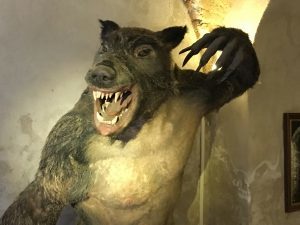 This greets you at the entrance of the torture museum
This greets you at the entrance of the torture museumSan Gimignano is one of several European cities with a Museo della Tortura (museum of torture). Just inside the entryway is a snarling werewolf (pictured left).
The museum purports to encourage visitors to become allies against torture in the present age by showing them the torture devices of the Middle Ages. Back home in Charlotte, North Carolina my city is making international news after a police shooting of an African-American man. While the full details of that case won’t be known until it goes to court, tensions are always high in police shootings, so I decide to skip the museum. I don’t need to be reminded of the progress the human race must make in accepting people who look, act, and believe differently than those in power.
Instead, I stroll through a decommissioned church that has been repurposed to house two small museums. On one side is an ornithological collection dating back to 1886, with 336 species and 1,136 individual birds, all encased in glass. I’m amazed by their pristine condition after 130 years.
The other side’s exhibit displays Etruscan and medieval archaeological treasures found nearby. I will get a fuller dose of Etruscan history in a few days when I visit Orvieto, and this wets my appetite.
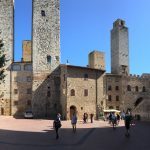
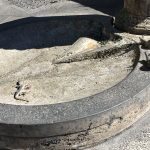
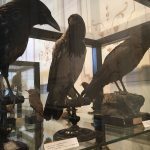
Following my nose to the olive grove
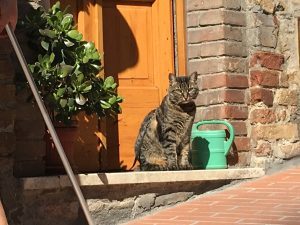 With another hour on the clock to explore the walled city the delightful scent of an olive grove wafts my way on a gentle breeze. As I follow its source, I become distracted by a domestic vignette of a woman sweeping her front stoop, her striped tabby cat watching from just outside the front door. A closer look reveals it is on a leash.
With another hour on the clock to explore the walled city the delightful scent of an olive grove wafts my way on a gentle breeze. As I follow its source, I become distracted by a domestic vignette of a woman sweeping her front stoop, her striped tabby cat watching from just outside the front door. A closer look reveals it is on a leash.
Cats that will tolerate a leash fascinate me to no end. The tabby watches me cautiously inch forward for a great snapshot portrait. Nothing in his composure tells me he is likely to scamper away, but as a precaution I take a shot with every step or so. Sure enough, a car comes down the via and it scampers inside. The matron smiles at me and tries to coax the cat back outside for “la signora,” to no avail.
A cat may submit to a leash, but that doesn’t make him your patsy.
I’ll tell you more stories from Italy this year, since I’m returning to ride my motorcycle through Tuscany, Corsica, and Sardinia in 2017. Subscribe in the purple button below and you’ll never miss an installment of the story.
Here is the beginning of the series. The next story will be about my “big yarn negotiation” in Greve in Chianti.
Follow this Italy Series
The post Tuscany Italy by Motorcycle: San Gimignano appeared first on Tamela Rich.

March 1, 2017
Appalachian Music Trails: Destinations in the Blue Ridge Mountains
Music is an easy way to celebrate Appalachian culture.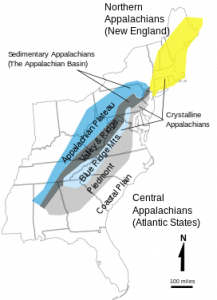
All American music can be traced to Appalachia. That’s where the cultural blend of European and African musical and rhythmic forms came together. Everything from jazz, old-time country music and Dixieland, to Cajun, soul, R&B, and rock ‘n’ roll, is a product of Appalachia’s cultural fusion.
When traveling in the Blue Ridge province, check out heritage music trails, where you’ll find concerts, festivals, and jamborees to enjoy as a member of the audience or as a participant on the dance floor. I talk about three of them—plus another in North Carolina’s coastal plains—in this post.
Here’s what you’ll experience on a music trail:
Fiddles and banjos ringing on stages and front porches every night of the week
Music halls where local musicians and music lovers gather to swap tunes and stories
Teams of cloggers, young and old, dancing up a storm
Ballads being sung as they were hundreds of years ago
Subscribe to this Appalachia Series
The Crooked Road
The Crooked Road in SW Virginia covers 19 counties. With nearly 70 venues and festivals, and over 25 wayside exhibits, even passers-through can find ways experience one of the richest music traditions in the world.
A wayside exhibit might celebrate where a legendary group formed and played, or where a song was written. All of them include panels to read and a five-minute audio recording about the heritage music and musicians in that location. The audio can be heard on your vehicle’s FM radio. How cool is that?
And while we’re talking about The Crooked Road I wouldn’t want you to miss Floyd General Store, which has a jamboree every Friday night. This video captures the vibe perfectly.
I’ll be bringing my motorcycle tour guests there in June, 2017. Even if you’re not able to visit Floyd on a Friday night, be sure to stop by and eat at the store, buy some souvenir music, then stroll the main drag’s quirky shops. I’ll just say, “You’re welcome,” in advance!
West Virginia’s Mountain Music Trail
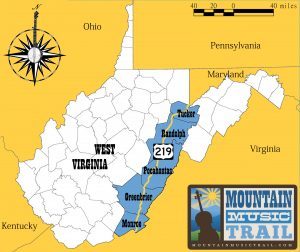 West Virginia’s Mountain Music Trail (MMT) area is pictured right. This region experienced devastating floods in 2016 and businesses are open and ready to welcome visitors. The summer festival season is strong.
West Virginia’s Mountain Music Trail (MMT) area is pictured right. This region experienced devastating floods in 2016 and businesses are open and ready to welcome visitors. The summer festival season is strong.
The MMT encompases some of the loveliest country in America, and I’ll be bringing my motorcycle tour guests to Pocahontas County in June, 2017 for a private concert.
I attended a MMT concert at the historic Marlinton Opera House in 2015, a real treat!
Two North Carolina Heritage Music Trails
 North Carolina is partially in Appalachia, partially piedmont and partially coastal plains.
North Carolina is partially in Appalachia, partially piedmont and partially coastal plains.
In the Appalachian part of the state, the Blue Ridge Music Trails consists of twenty-nine counties in the western third of the state, a region that includes the Blue Ridge Parkway.
In the coastal plains region, North Carolina offers us the They take you through the rural landscape of Eastern North Carolina where green tobacco fields and historic tobacco warehouses dot the landscape. This “Our State” video will make you want to dance!
Subscribe to this Appalachia Series
The post Appalachian Music Trails: Destinations in the Blue Ridge Mountains appeared first on Tamela Rich.

February 24, 2017
Italy’s Lazio Region by Motorcycle: Ronciglione and Bolsena
This is Part Two of my series on Italy by motorcycle. Start the series here.
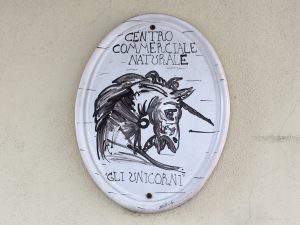 The unicorn is prevalent in Ronciglione, taken from a ruling family’s heraldry
The unicorn is prevalent in Ronciglione, taken from a ruling family’s heraldryDay Two finds us north of The Eternal City, in the medieval burgh of Ronciglione, now home to fewer than 9,000 people. Our guide Enrico tells us we have 45 minutes to grab a cuppa, answer nature’s call, and explore the town.
The village elders sitting on a bench by the row where we park our bikes smile broadly, their work-hardened hands gesticulating as they gossip amongst themselves, perhaps at our expense.
Free-range kids
I jump off the bike, grab my camera, and head into the heart of village life. Since it’s a Saturday morning, things are hopping. Little girls push their pink bicycles up the steep alleyways toward the piazza. Women hanging their wash on lines strung below their windows greet the girls from their apartments above.
I had a momentary flashback to my own childhood, before hypervigilant parenting became the norm. After chores were finished we were told to “go outside and play.” Wherever we got hungry we would go to the closest home for lunch or a snack, then be told the same thing, “go outside and play.” It pleases me to see these kids enjoying a free-range childhood.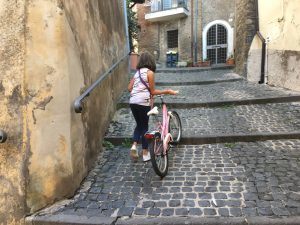
It’s an agricultural community, producing nuts—think “Nutella”—chestnuts, and wine. The steep alleyways make me wish I could see the town in a thunderstorm; where would all that water flow?
Seeing a VENDI sign (“For Sale”) on a arched wooden door of an apartment I find myself thinking, “I could totally live here,” with no pre-cognition that I will say that to myself at least once in each coming day.
Reaching the piazza with its lovely fountain in the traffic circle, I spy my traveling companions Jo and Dan coming out of the cathedral before promptly getting lost in the rabbit warren of streets.
By the time I get back to the rest of my group I am 20 minutes past our allotted visiting time. I think to myself, nuts, I’m now officially “that person.” Luckily no one seems to mind. They’re as intoxicated by Ronciglione’s charms as I.
Follow this Italy Series
Bolsena’s broccoletti
Mounting back up, we ride the splendid coastline road that runs along the shores of Lake Bolsena, a volcanic crater lake reportedly over 370,000 years old. We stop for lunch in the village of Bolsena for a bite to eat.
Enrico designed the itinerary not to make road warriors of us, but to balance our love of motorcycling with a deep cultural immersion in his native land. This includes lots of stops in small villages and Enrico’s help navigating the shops.
We stroll the vias (narrow roads) looking at shops and crowd lines for the various eateries when Enrico spies what we would call a green grocer. He says with urgency, “Tamela, let’s go find some broccoletti.”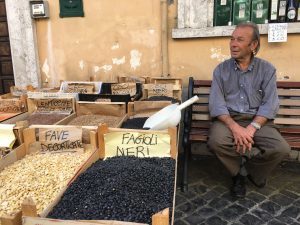
Broccoletti has been a point of dispute and discussion between the two of us since my first dinner in Rome. The night before our tour began, I ate a skillet dish of beef and vegetables, including what the waiter claimed was broccoletti. Thinking perhaps the waiter and I had a misunderstanding I asked Enrico about it—did Americans and Italians use the same word for different plants?
“No,” he said. “Broccoletti is broccoletti,” but I persisted that we were talking about different things. The dish I had enjoyed—to the point of asking for a second helping—had none of the tiny buds atop skinny stalks; it was more like what Southerners call “greens.”
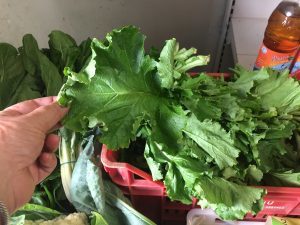 In the doorway of La Boutique della Frutta Enrico begins scanning the baskets of produce to the right. Holding up a bunch of greens he smiles. “This, Tamela, is the broccoletti, no?” And sure enough. He’s right.
In the doorway of La Boutique della Frutta Enrico begins scanning the baskets of produce to the right. Holding up a bunch of greens he smiles. “This, Tamela, is the broccoletti, no?” And sure enough. He’s right.
We’re both right.There are only greens, no stems or buds. In Italy broccoletti can be served without the scrawny stalks as a delicious green. Case closed.
Bagno Vignoni
After lunch we cross into the region of Tuscany en route to Siena. At our stop in Bagno Vignoni, famous for its thermal water and spa treatments, families mix with tourists on the park grounds.
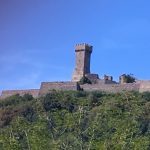
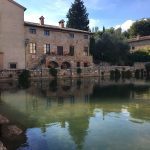
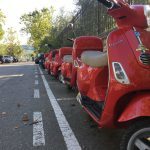
I smile at a long row of Vespa scooters available for rent. Scooters are cute, but I like being on a motorcycle, so I can throttle through the twisty climbs of Siena’s hilly landscapes. The riding is spectacular: well-maintained roads are always sweeping this way and that, with ancient vineyards and castles dotting the landscape. As I mentioned in this post, the Italians respect motorcyclists, so despite being on unfamiliar terrain I don’t have to worry about Italian road rage.
We end the day at a luscious agriturismo B&B on an olive farm overlooking Siena’s skyline, where the sun is sinking fast, casting a yellow haze above the red-brown clay of the walled city.
Follow this Italy Series
The post Italy’s Lazio Region by Motorcycle: Ronciglione and Bolsena appeared first on Tamela Rich.

February 10, 2017
Appalachian Roots Music: What’s with the Banjo?
I never learned to like bluegrass music as a child of the 1970’s. After all, we had the Rolling Stones, The Who, and Fleetwood Mac on the AM/FM dial so who needed that old timey stuff?
(How ironic,the words “AM/FM dial” when talking about old timey stuff).
And why were banjos only played in bluegrass music? Other than Saturday nights when I watched Hee Haw with my grandparents, the only banjo player I remember from my childhood was Steve Martin in his trademark white suit on SNL—sometimes with an arrow “through” his head.
Martin’s comedic repertoire was a distraction from how well he played the instrument. He would even tell jokes like, “I always bring two banjos, in case one is in tune.” 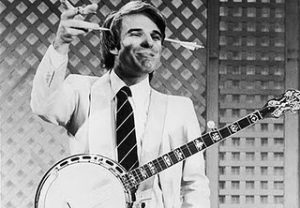
The first time I visited the Blue Ridge Music Center (on the Blue Ridge Parkway near the Virginia-North Carolina state line) I truly listened to banjo music for the first time—and fell in love. More proof that with age, wisdom is possible.
Banjos are considered happy-sounding instruments, and perhaps that’s why they didn’t get much play in the wake of the Great Depression. With the rise of bluegrass music in the late 1930’s and 1940’s the instrument came into its own.
Subscribe to this Appalachia Series
African-Americans and the banjo
You’ve seen white musicians like Steve Martin and Béla Fleck playing the banjo, but when’s the last time you saw someone of African descent playing it to acclaim?
With the exception of Carolina Chocolate Drops, not very often. A quick review of the history tells us why.
“Jim Crow,” the minstrel player
At the Blue Ridge Music Center I learned that after African slaves were forbidden by slaveholders to play their drums, they created the banjo using gourds, wood, and tanned skins, with hemp or gut for strings.
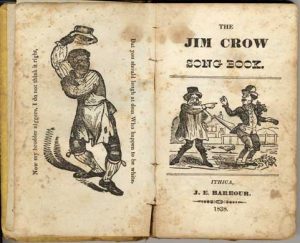 They abandoned their creation in the mid-1800’s, when minstrel shows became the rage. The shows featured white men in blackface playing banjos and baffooning in a racist way.
They abandoned their creation in the mid-1800’s, when minstrel shows became the rage. The shows featured white men in blackface playing banjos and baffooning in a racist way.
“Jim Crow laws” were named after a minstrel performer of the same name, whose character was devised to reinforce beliefs in black inferiority.
Jim Crow played a banjo.
Celebrating roots music on the Appalachian Mountains & Music Motorcycle Tour
Roots music, which includes bluegrass, is a fascinating amalgam of European, African and Early American traditions. The Blue Ridge Music Center is the perfect place to come to understand and love it in its many forms.
Subscribe to this Appalachia Series
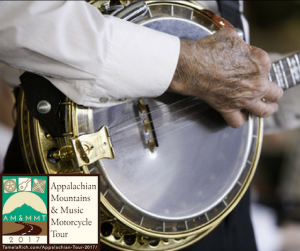 If you’re a motorcyclist I hope to entice you to join me in June, 2017 on the Appalachian Mountains & Music Motorcycle Tour. We’ll be treated to two private bluegrass concerts AND spend some time in the Blue Ridge Music Center, where you can learn about the origins of bluegrass, blues and gospel music.
If you’re a motorcyclist I hope to entice you to join me in June, 2017 on the Appalachian Mountains & Music Motorcycle Tour. We’ll be treated to two private bluegrass concerts AND spend some time in the Blue Ridge Music Center, where you can learn about the origins of bluegrass, blues and gospel music.
Watch the video below from the Blue Ridge Music Center at about 2:25 and you’ll see two of the musicians who’ll be entertaining us on our tour, Wayne Henderson and Helen White.
The post Appalachian Roots Music: What’s with the Banjo? appeared first on Tamela Rich.

February 6, 2017
Appalachian Mountains and Music Motorcycle Tour: Save $150
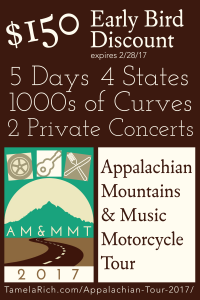 There are lots of motorcycle “bucket list rides” in Appalachia, especially the Blue Ridge province. As a matter of fact Motorcycle Roads website ranks 30 of the top 100 motorcycling roads in America in the region. Many of these top roads are in the Blue Ridge province where my Appalachian Mountains & Music Motorcycle Tour (AMMMT) is centered.
There are lots of motorcycle “bucket list rides” in Appalachia, especially the Blue Ridge province. As a matter of fact Motorcycle Roads website ranks 30 of the top 100 motorcycling roads in America in the region. Many of these top roads are in the Blue Ridge province where my Appalachian Mountains & Music Motorcycle Tour (AMMMT) is centered.
The AMMMT tour explores the most scenic and twisty roads in Virginia, West Virginia, Tennessee, and North Carolina, and will give my guests a cultural appreciation for a region that is often misunderstood.
Two private concerts on the motorcycle tour
I booked two private bluegrass concerts for the tour, including one by the legendary picker Wayne Henderson. He played at Carnegie Hall, in three national tours of Masters of the Steel-String Guitar, and in seven nations in Asia.
Here’s a clip of Wayne Henderson and Helen White playing for Queen Elizabeth when she visited Virginia. I’m so happy they will be serenading us by the banks of the New River on our second night of the tour.
If you’re interested, time is drawing to a close for the Early Bird Discount on the tour. Reserve your seat by February 28 and you’ll save $150 on the total price.
Download the full tour itinerary, pricing and terms here.
The post Appalachian Mountains and Music Motorcycle Tour: Save $150 appeared first on Tamela Rich.

Save $150 on Appalachian Mountains and Music Motorcycle Tour
 There are lots of motorcycle “bucket list rides” in Appalachia, especially the Blue Ridge province. As a matter of fact Motorcycle Roads website ranks 30 of the top 100 motorcycling roads in America in the region. Many of these top roads are in the Blue Ridge province where my Appalachian Mountains & Music Motorcycle Tour (AMMMT) is centered.
There are lots of motorcycle “bucket list rides” in Appalachia, especially the Blue Ridge province. As a matter of fact Motorcycle Roads website ranks 30 of the top 100 motorcycling roads in America in the region. Many of these top roads are in the Blue Ridge province where my Appalachian Mountains & Music Motorcycle Tour (AMMMT) is centered.
The AMMMT tour explores the most scenic and twisty roads in Virginia, West Virginia, Tennessee, and North Carolina, and will give my guests a cultural appreciation for a region that is often misunderstood.
Two private concerts on the motorcycle tour
I booked two private bluegrass concerts for the tour, including one by the legendary picker Wayne Henderson. He played at Carnegie Hall, in three national tours of Masters of the Steel-String Guitar, and in seven nations in Asia.
Here’s a clip of Wayne Henderson and Helen White playing for Queen Elizabeth when she visited Virginia. I’m so happy they will be serenading us by the banks of the New River on our second night of the tour.
If you’re interested, time is drawing to a close for the Early Bird Discount on the tour. Reserve your seat by February 28 and you’ll save $150 on the total price.
Download the full tour itinerary, pricing and terms here.
The post Save $150 on Appalachian Mountains and Music Motorcycle Tour appeared first on Tamela Rich.

January 31, 2017
Driving a Motorcycle in Rome: My Surprising Experience
I’ve been chasing an Italian man riding a BMW GS Wasserboxer motorcycle for the last six days through Lazio, Tuscany, and Umbria. Tomorrow we’ll be back to Rome, where the entire adventure began.
My husband fully approves. We have an understanding.
Rome traffic and the social contract
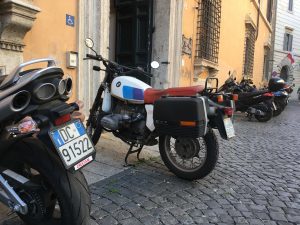 Motorcycles are everywhere in Rome
Motorcycles are everywhere in RomeOn the first day of my riding adventure, Wasserboxer Man wants me to learn Italian traffic conventions. I follow his lead through Rome’s notorious traffic, shooting through gaps so narrow that I tilt my handlebars to avoid the mirrors of the vehicles on either side of me. Maybe that’s unnecessary, but I feel more confident doing it. Eventually I learn not to overthink it.
When we come to a stoplight, we navigate to the front of the line of vehicles. Nobody cares, in fact they have left room for us. Moving to the shoulder, I stand on the pegs to make riding over tree roots beneath the pavement more comfortable. No reaction from the drivers I pass.
I’m having my way with this traffic—splitting to the right and left of cars—with impunity. When you split a lane into oncoming traffic, drivers don’t rush toward the center line in a game of “chicken” designed to put you in your place—instead, they edge over to the shoulder a bit so you can make an efficient pass. Mutual respect is a beautiful thing in society.
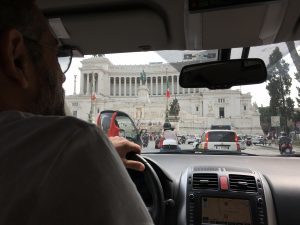 Traffic from inside a Rome cab
Traffic from inside a Rome cabAstride my rented G650 GS I learn that traffic in Rome is less governed by laws, lanes, and speed limits than by an implicit social contract that values efficiency above all else. Yep, I just used the words “Italian” and “efficiency” in the same sentence with no implied irony.
Let’s all get where we need to go efficiently seems to be the guiding principle when driving in Italy. Italian motorists respect motorcyclists. They know that allowing scooters and motorcycles to the front of the line at traffic lights is efficient. Nobody opens a car door to see if they can take you out—that would be highly inefficient and disrespectful.
Yes, Rome traffic is hectic, yet manageable. I did it, so you can too.
By the time we reach Rome’s beach, Ostia Lido, I’m exhilarated. Heading to the water’s edge in my motorcycle pants and boots, I collect seashells from the Tyrrhenian Sea as a trophy of my accomplishment.
I’m warmed up now, Wasserboxer Man. Let’s go. Follow this Italy Series
“Ladies First” motorcycle tour
Wasserboxer Man has other concerns right now, namely the other people in his care. He is Enrico Grassi, owner of Hear The Road Motorcycle Tours Italy and host to a group of Americans on his “Ladies First” tour. We’re from Pennsylvania, Louisiana, Missouri, California, Texas, and North Carolina (me), and not all women—Dan and Derek accompany their mates.
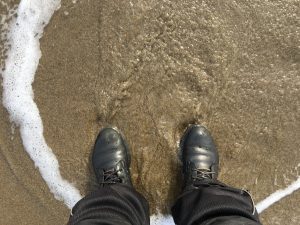 Tamela’s boots in the Tyrrhenian Sea
Tamela’s boots in the Tyrrhenian SeaYou can never know how a group ride is going to work; after all, one bad rider or bad attitude can turn the experience into a living hell. That’s one thing back home, but in a foreign country you’re not going to peel away from a tour with a breezy arrivederci. My friend Bill Kniegge of Blue Strada Tours convinced me I should give it a try and put me in touch with Enrico.
My concerns are allayed after our warm-up ride to the Tyrrhenian Sea. Riding BMW, Moto Guzzi and Harley-Davidson bikes, we sorted ourselves into a riding order that held naturally for the remainder of the tour. I would know Christin’s Moto Guzzi V7 headlight anywhere after watching for it in my mirrors for six days in formation.
Off the bikes, into the bread
Off the bikes we laugh and tease each other like old friends. The couple from Pennsylvania, Jo and Dan, share stories of her father, Giovanni, whom they agree that Enrico reminds them of. Both Giovanni and Enrico are Roman, and hold staunch views that there are certain foods to eat and certain ways to eat them.
Enrico will indoctrinate us in Italian gastronomy with each meal: how the animal is raised and butchered; when the plant is harvested; how to keep pasta from sticking; and the fact that pork jowl (guanciale) not only tastes better than pancetta, which comes from its belly, it is the only pork allowed in amatriciana (a staple pasta dish that also includes pecorino cheese, white wine, tomatoes from San Marzano, pepper and chili).
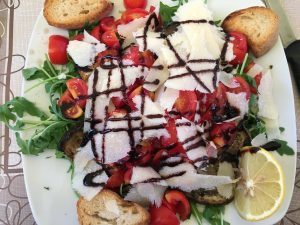 Fabulous Italian salad
Fabulous Italian saladBread becomes an ongoing joke among us, especially between Enrico and Dan—the bread lover in our group. “Don’t touch the bread!” Enrico says each time it’s brought to the table. “Eat first, then use the bread to soak up the sauce.”
Jo and Dan exchange knowing looks, because Enrico’s admonition recalls a memory from when they were dating some 40 years ago and Dan was invited to family meals. He always wanted butter on his bread but Giovanni wouldn’t stand for it. Eventually Jo’s mother would take pity and bring him some, inviting her husband’s scorn. Another transgression of young Dan’s was asking for garlic bread with spaghetti, an American tradition, only to learn that this made him a Philistine in Giovanni’s eyes. It’s a wonder they got permission to marry!
As the tour proceeds and more stories of Giovanni are revealed, we all begin to think of him as the tenth person at the table. This right here is group touring at its best. I count my blessings. The video at the top of this post was a Facebook Live broadcast we took after returning to our hotel in Rome.
I’ll tell you more stories from Italy this year, since I’m returning to ride my motorcycle through Tuscany, Corsica, and Sardinia in 2017. Subscribe in the purple button below and you’ll never miss an installment of the story.
Follow this Italy Series
The post Driving a Motorcycle in Rome: My Surprising Experience appeared first on Tamela Rich.





